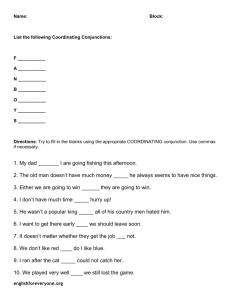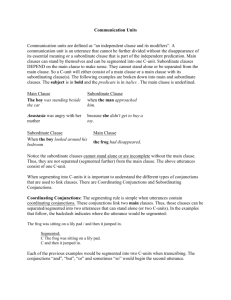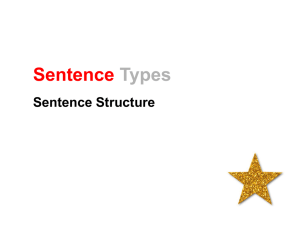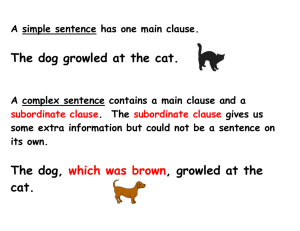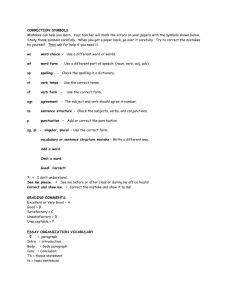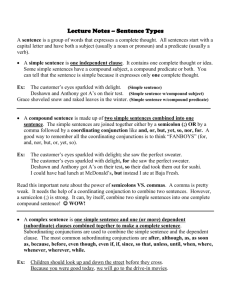segmentation of utterances into “c” units
advertisement
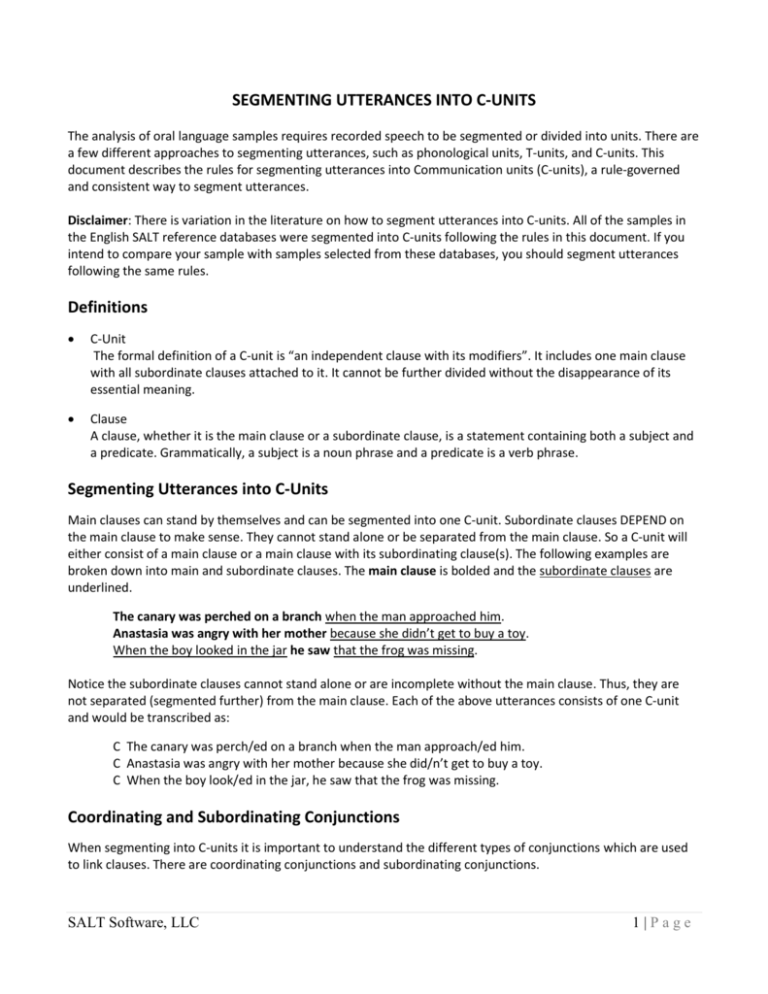
SEGMENTING UTTERANCES INTO C-UNITS
The analysis of oral language samples requires recorded speech to be segmented or divided into units. There are
a few different approaches to segmenting utterances, such as phonological units, T-units, and C-units. This
document describes the rules for segmenting utterances into Communication units (C-units), a rule-governed
and consistent way to segment utterances.
Disclaimer: There is variation in the literature on how to segment utterances into C-units. All of the samples in
the English SALT reference databases were segmented into C-units following the rules in this document. If you
intend to compare your sample with samples selected from these databases, you should segment utterances
following the same rules.
Definitions
C-Unit
The formal definition of a C-unit is “an independent clause with its modifiers”. It includes one main clause
with all subordinate clauses attached to it. It cannot be further divided without the disappearance of its
essential meaning.
Clause
A clause, whether it is the main clause or a subordinate clause, is a statement containing both a subject and
a predicate. Grammatically, a subject is a noun phrase and a predicate is a verb phrase.
Segmenting Utterances into C-Units
Main clauses can stand by themselves and can be segmented into one C-unit. Subordinate clauses DEPEND on
the main clause to make sense. They cannot stand alone or be separated from the main clause. So a C-unit will
either consist of a main clause or a main clause with its subordinating clause(s). The following examples are
broken down into main and subordinate clauses. The main clause is bolded and the subordinate clauses are
underlined.
The canary was perched on a branch when the man approached him.
Anastasia was angry with her mother because she didn’t get to buy a toy.
When the boy looked in the jar he saw that the frog was missing.
Notice the subordinate clauses cannot stand alone or are incomplete without the main clause. Thus, they are
not separated (segmented further) from the main clause. Each of the above utterances consists of one C-unit
and would be transcribed as:
C The canary was perch/ed on a branch when the man approach/ed him.
C Anastasia was angry with her mother because she did/n’t get to buy a toy.
C When the boy look/ed in the jar, he saw that the frog was missing.
Coordinating and Subordinating Conjunctions
When segmenting into C-units it is important to understand the different types of conjunctions which are used
to link clauses. There are coordinating conjunctions and subordinating conjunctions.
SALT Software, LLC
1|Page
Coordinating Conjunctions
The segmenting rule is simple when utterances contain coordinating conjunctions. These conjunctions link
two main clauses which should be separated/segmented into two utterances (or two C-units) that can each
stand alone. Common coordinating conjunctions include: and, but, so (but not “so that”), and then, then.
Example 1:
C The frog was sit/ing on a lily pad.
C And then it jump/ed in.
Example 2:
C He had to catch the frog.
C Or the waiter would make them leave.
Example 3:
C He climb/ed up on the branch/s.
C But they were/n’t branch/s.
Example 4:
C My aunt gave me money for my birthday.
C So I use/ed it to buy some new jeans.
Subordinating Conjunctions
Subordinating conjunctions link a main clause and a subordinate clause. A C-unit includes the main clause
with all subordinate clauses attached to it. The following are examples of subordinating conjunctions:
Early Development: because, that, when, who
Later Development: after, before, so (that), which, although, if, unless, while, as, how, until, as__as, like,
where, since, although, who, before, how, while
Examples:
C He went to the store because he was out of milk.
C When the boy saw it, the frog jump/ed.
C The man, who usually come/3s to my exercise class, was/n’t there today.
C We can/’t find my cat who always run/3s away.
“because” and “so”
Always consider "because" as a subordinating conjunction (it will never begin an utterance) unless it is
preceded by the utterance of another speaker as in this example:
C I like/ed the movie alot.
E Why did you like it?
C Because it was really funny.
The word “so” can be either a coordinating conjunction or a subordinating conjunction. If its usage means
“so that”, it is a subordinating conjunction. Otherwise it is a coordinating conjunction.
Example 1 (“so” used as a coordinating conjunction):
C He had to go home.
C So we could/n’t go to the game.
Example 2 (“so” used as a subordinating conjunction):
C He had to go home so his mom could take him to the dentist.
SALT Software, LLC
2|Page
Other rules for segmenting C-units
Sentence fragments
Sentence fragments are counted as separate C-units when the final intonation contour of the utterance
indicates that a complete thought has been spoken. For example:
C The boy, the dog, and the frog, they were friend/s.
versus
C The boy, the dog, and the frog. { fragment based on intonation }
C They were friend/s.
Elliptical responses
Elliptical responses (sentence fragments) to questions or prompts from the examiner are counted as
separate C-units. For example:
E What did you do next?
C Shop/ed.
Yes/No responses
Separate the yes/no response from the utterance which follows it. For example,
E Is that the Spanish teacher?
C No.
C That/'s my Science teacher.
Tags
Do not segment phrases such as “you know”, “I guess”, and “I mean” when they are used as tags. For
example,
C He/’s gonna live with his dad, I guess.
C And then, you know, they were go/ing to this town.
Questions as Tags
Do not segment questions when they are used as tags. For example,
C They got in trouble, right?
C He miss/ed the bus, did/n't he?
C That movie was good, would/n't you agree?
Dialogue Complement/Complement
Dialogue quotes which are embedded in, or as part of, an utterance are counted as one C-unit as in this
example:
C And the boy said, “That/’s my frog”.
Successive main clauses that occur in dialogue quotes are counted as separate C-units. For example,
C And he said, “I/’m ready”.
C “I want to go to the store now”.
Complement:
C She thought, Sam was incorrect.
C He realized, nothing has changed
SALT Software, LLC
3|Page
Grammatical errors
Ignore grammatical errors when segmenting utterances. For example,
C They is[EW:are] go/ing now.
{ child said, “They is going now.” }
C We *are go/ing too.
{ child said, “We going too.” }
Pauses and intonation
Do not ignore pauses and intonation when segmenting utterances but, whenever reasonable, segment
utterances based on grammar rules. When listening to speech, for example, there is sometimes a significant
pause (with or without ending intonation) between a main clause and a subordinate clause. This inclines one
to segment the utterance. With C-unit segmentation, however, the utterance would not be segmented as in
this following example where the speaker paused for two seconds between the main clause and the
subordinate clause:
C I like/ed the movie alot :02 because it was really funny.
In the following segment, however, you have to consider pause time and intonation:
C I like/ed the movie alot.
: :02
E Mhm.
C Because it was really funny.
If there is a significant pause and ending intonation (falling for statements, rising for questions) between the
speaker’s first utterance and the examiner’s “Mhm”, segment the utterances as show above. Otherwise,
give the speaker credit for subordination and transcribe these "prompt sounds" as interjections as follows:
C I like/ed the movie alot :02 < > because it was really funny.
E <Mhm>.
References
The rules for C-unit segmentation were summarized from the following sources:
Hughes, D., McGillivray, L., & Schmidek, M., Guide to Narrative Language; Procedures for Assessment, 1997.
Loban, W., Language Development: Kindergarten through Grade Twelve, 1976.
Miller, J.F., Class notes from Communicative Disorders 640, Fall, 1999.
Strong, C.J., The Stong Narrative Assessment Procedure, 1998.
SALT Software, LLC
4|Page
